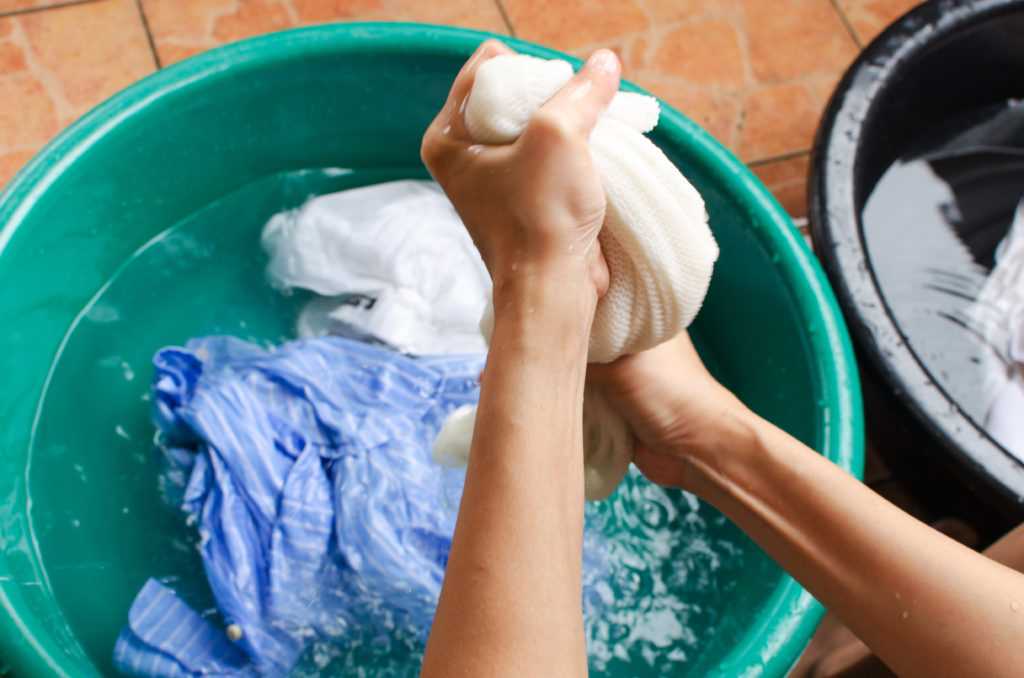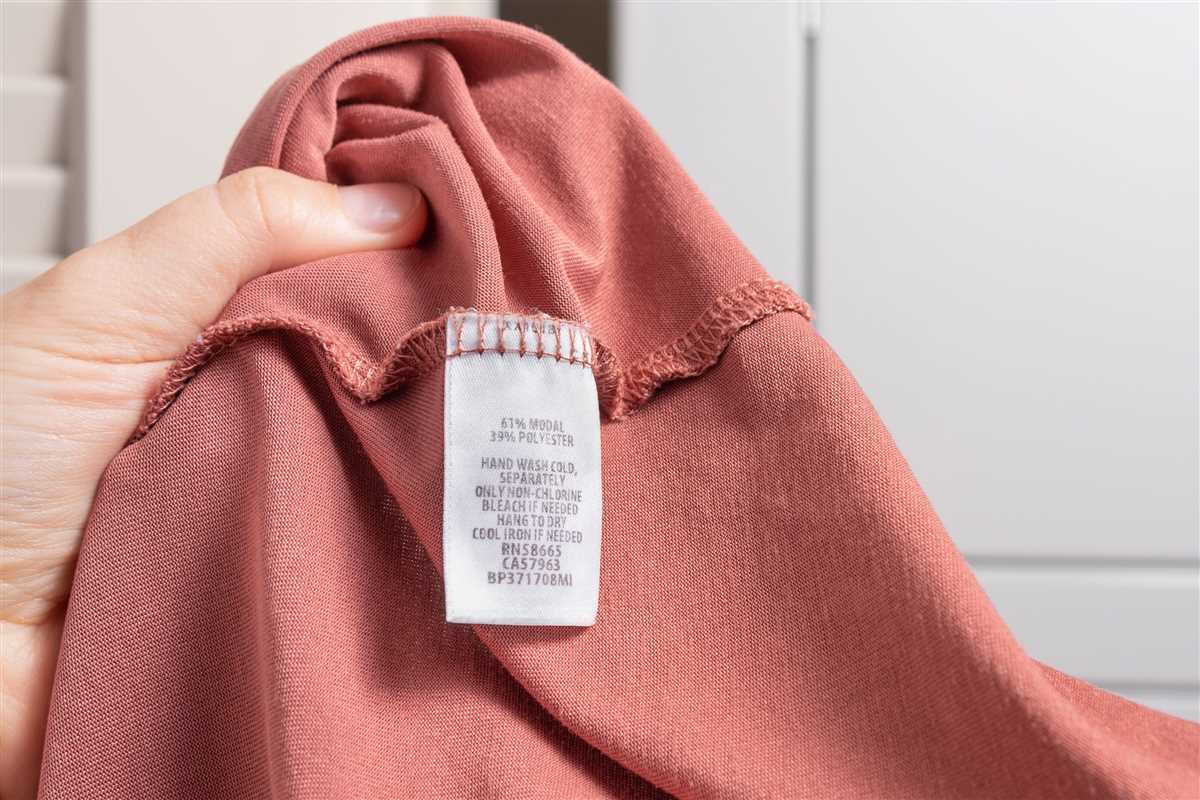




Hand-washing clothes is a great way to ensure they are properly cleaned and well-maintained. However, once you’ve washed your clothes by hand, it’s equally important to dry them correctly to avoid damage or shrinking. In this article, we will provide you with some useful tips and techniques on how to properly dry your hand-washed clothes.
1. Squeeze out excess water
After hand-washing your clothes, gently squeeze out the excess water by pressing them against the sides of the sink or basin. Avoid wringing or twisting the clothes, as this can cause stretching or damage to the fabric. Squeezing out the excess water will help expedite the drying process.
2. Lay flat to dry
For most hand-washed clothes, it’s best to lay them flat to dry. This method is especially suitable for delicate fabrics such as silk or cashmere. Lay the clothes on a clean, dry towel or a drying rack, making sure they are spread out evenly. Avoid hanging them up, as this can stretch the fabric and cause it to lose its shape.
3. Air dry in a well-ventilated area
Avoid drying hand-washed clothes in direct sunlight, as this can cause the colors to fade. Instead, choose a well-ventilated area indoors or outdoors, away from direct heat sources. This will allow the clothes to air dry naturally without being subjected to excessive heat or humidity.
Tip: If you need to accelerate the drying process, you can place a fan nearby to improve air circulation.
By following these tips and techniques, you can ensure that your hand-washed clothes are properly dried, maintaining their quality and extending their lifespan. Taking the time to dry your clothes correctly will help you achieve the best results and continue enjoying your favorite garments for years to come.
Why Hand-Washed Clothes Require Proper Drying
Hand-washing clothes can be a time-consuming process that requires effort and care. Once the clothes are washed, it is essential to give them proper drying to ensure that they are clean, fresh, and ready to wear. Here are a few reasons why hand-washed clothes require proper drying:
1. Maintaining the Quality

Proper drying is crucial to maintaining the quality of hand-washed clothes. Air drying or using a clothesline helps prevent damage caused by excessive heat, which can weaken fabrics, fade colors, or shrink the material. By allowing clothes to dry naturally, you can extend their lifespan and keep them in great condition for longer.
2. Preventing Mould and Mildew
Hand-washed clothes are often damp after the washing process, and if not dried properly, they can become a breeding ground for mould and mildew. These fungi thrive in moist environments and can cause unpleasant odors and stains on clothes. By ensuring thorough drying, you can prevent the growth of mould and maintain the freshness of your hand-washed items.
3. Avoiding Wrinkles and Creases
Improper drying can lead to wrinkles and creases in hand-washed clothes. Hanging or laying the garments flat to dry allows them to naturally regain their shape and reduce the need for extensive ironing or steaming. This not only saves time but also helps preserve the fabric’s texture and appearance.
4. Eliminating Odors and Improving Hygiene
Properly dried clothes eliminate any lingering odors or dampness that may have occurred during the hand-washing process. The fresh air and sunlight can help remove any bacteria or unpleasant smells, ensuring that your clothes are clean and hygienic. Additionally, drying under the sun can act as a natural disinfectant, adding an extra level of cleanliness to your hand-washed items.
Conclusion
Properly drying hand-washed clothes is essential for maintaining their quality, preventing the growth of mould and mildew, avoiding wrinkles and creases, and ensuring cleanliness and hygiene. By following the appropriate drying techniques, you can keep your hand-washed clothes in excellent condition and enjoy the benefits of fresh, clean garments.
The Importance of Drying Hand-Washed Clothes Correctly
Properly drying hand-washed clothes is essential to maintain their quality and ensure they are ready for future use. While hand-washing clothes can be a gentle and effective method to clean delicate fabrics or items that require special care, it is equally important to handle the drying process correctly. Here are some reasons why drying hand-washed clothes correctly is crucial:
- Preserving the fabric: Correct drying techniques help to prevent damage to the fabric. Hand-washed clothes are often made of delicate materials that can be easily stretched, shrunk, or warped when exposed to excessive heat or improper drying methods. By following the appropriate drying techniques, you can preserve the fabric’s integrity and prolong the lifespan of your clothes.
- Avoiding wrinkles: Drying clothes in the correct manner helps to minimize wrinkling. Improper drying such as squeezing or twisting the clothes vigorously can lead to stubborn wrinkles. By gently reshaping the garments and allowing them to air dry or using a low-heat setting on a dryer, you can reduce the appearance of wrinkles and save time on ironing or steaming.
- Preventing color fading: Proper drying techniques can help to prevent color fading. Hanging clothes in direct sunlight for extended periods or using high-heat settings in a dryer can cause colors to fade over time. By choosing a shaded or well-ventilated area for air drying or using a low-heat setting, you can help preserve the vibrancy of your hand-washed clothes.
- Ensuring hygiene: Correctly drying hand-washed clothes is essential for maintaining hygiene. Damp clothes that are not dried thoroughly can become a breeding ground for bacteria and mold. This can lead to unpleasant odors and potential health issues. By ensuring that your clothes are completely dry before storing or wearing them, you can avoid these problems.
Choosing the Right Drying Method
When it comes to drying hand-washed clothes, there are several methods you can choose from. The right drying method will depend on the fabric type and your personal preferences. Here are some options to consider:
Air Drying
Air drying is one of the most common and popular methods for drying hand-washed clothes. It is gentle on fabrics and helps prevent shrinkage or damage. To air dry your clothes, simply hang them on a clothesline, drying rack, or clothes hanger. Make sure to arrange them in a way that allows air to circulate and dry the clothes evenly.
Flat Drying
Flat drying is recommended for delicate fabrics that may lose their shape or stretch if hung. Lay the clothes flat on a clean, dry towel or drying rack, and gently reshape them to their original form. Allow them to air dry completely before folding or storing them.
Tumble Drying
Not all hand-washed clothes are suitable for tumble drying, as the heat and agitation can cause damage. However, some fabrics like cotton or polyester may be tumble dried on low or gentle settings. Check the care label or manufacturer’s instructions for specific guidance before using this method.
Using a Clothes Dryer
If you have a clothes dryer, you can also use it to dry hand-washed clothes. Make sure to select a low heat setting and use a delicate or low-tumble option to minimize the risk of damage. Also, remember to remove the clothes from the dryer promptly to prevent wrinkles.
Combining Drying Methods
In some cases, combining drying methods can be effective. For example, you can air dry your clothes partially and then finish them off in a clothes dryer on a low heat setting. This approach can help reduce drying time while still keeping your clothes in good condition.
Test and Evaluate
Regardless of the drying method you choose, it’s always a good idea to test a small, inconspicuous area of the clothes first. This will help you assess how the fabric responds to the drying method and whether any damage or shrinkage occurs. If the test goes well, you can proceed to dry the rest of the clothes using the chosen method.
Remember, different fabrics require different care methods. Always refer to the care label or manufacturer’s instructions for specific guidelines on drying hand-washed clothes.
Air Drying: The Traditional Approach
Air drying clothes is the most traditional and eco-friendly way to dry hand-washed laundry. It involves hanging garments outside or in a well-ventilated area to let the natural airflow take care of the drying process.
Advantages of Air Drying
- Energy-efficient: Air drying does not require any electricity or gas, making it an environmentally friendly method.
- Saves money: By avoiding the use of a dryer, you can save on utility bills.
- Preserves fabric: Air drying reduces the wear and tear on clothes caused by high heat and tumbling in a dryer, thereby prolonging their lifespan.
- Eliminates shrinkage: Many fabrics can shrink when exposed to high heat, but air drying eliminates this risk.
Tips for Air Drying
- Choose a suitable location: Find a well-ventilated area, such as a balcony, clothesline, or drying rack, to hang your hand-washed clothes.
- Separate garments: Hang similar fabrics together to ensure consistent drying times.
- Shake out the clothes: Before hanging, gently shake each garment to help remove wrinkles and facilitate faster drying.
- Arrange clothes on hangers or clotheslines: Hang shirts, blouses, and dresses on hangers or use clothespins to secure them to a clothesline. This allows better airflow and prevents stretching or misshaping of the garments.
- Spread out heavy items: When drying heavy items like towels or jeans, it’s essential to spread them out to avoid overloading the drying area and ensure proper drying.
- Flip clothes: If necessary, flip the clothes midway through the drying process to ensure both sides receive adequate airflow.
- Prevent sun damage: Strong sunlight can fade colors, so consider drying colorful or delicate items in the shade to preserve their vibrancy.
Air Drying Time
The drying time for air-dried clothes depends on various factors such as humidity, air temperature, and the fabric’s thickness. In general, it can take anywhere from a couple of hours to a full day for clothes to dry completely. It’s important to check the garments intermittently and make sure they are completely dry before storing or wearing them.
Using Drying Racks or Clotheslines
When hand-washing clothes, using a drying rack or clothesline can be an effective and energy-efficient way to dry your garments. Here are some tips and techniques for utilizing drying racks or clotheslines:
1. Choose the Right Drying Rack
Select a drying rack that suits your space and needs. Consider the size and capacity of the rack, as well as its portability and durability.
2. Set Up a Clothesline
If you have access to an outdoor area, setting up a clothesline can be a great alternative to using a drying rack. Make sure the line is sturdy and secure, allowing enough space for clothes to hang freely and properly dry.
3. Hang Clothes Appropriately

When using a drying rack or clothesline, it’s important to hang clothes in a way that promotes efficient drying and minimizes wrinkles. Shake each item gently before hanging to remove excess water and smooth out wrinkles.
Use clothespins or clips to attach clothes securely to the rack or line. Avoid overcrowding the rack or line, as this can prevent proper air circulation and slow down the drying process.
4. Place the Rack or Line in the Right Location
Position the drying rack or clothesline in a well-ventilated area, preferably near a source of natural light or warm airflow. This will help speed up the drying process and prevent any unpleasant odors from lingering.
5. Rotate and Flip Clothes
To ensure even drying, periodically rotate and flip the clothes as they dry. This will help prevent any damp spots from forming and encourage quicker drying times.
6. Bask in the Sun’s Rays
If weather permits, take advantage of sunny days by placing the drying rack or clothesline in direct sunlight. The sun’s rays can act as a natural disinfectant and aid in the drying process.
7. Consider Indoor Drying
If you don’t have access to an outdoor space or the weather is unsuitable, utilize indoor drying options such as placing the drying rack in a well-ventilated room or using a collapsible clothesline indoors.
8. Be Mindful of Clothing Material

Some delicate materials may not be suitable for drying racks or clotheslines, as they can stretch or lose their shape. Consider drying these items on a flat surface instead.
Using drying racks or clotheslines can not only save energy but also help prolong the lifespan of your clothes. By following these tips and techniques, you can efficiently and effectively dry your hand-washed garments.
Tips for Drying Hand-Washed Clothes Indoors

Drying hand-washed clothes indoors can be a challenge, but with the right techniques, you can ensure that your clothes dry quickly and maintain their shape and quality. Here are some tips to help you dry hand-washed clothes indoors:
- Squeeze out excess water: Before hanging your clothes to dry, gently squeeze out the excess water. Avoid wringing or twisting the fabric, as this can cause stretching or damage.
- Use a drying rack or clothesline: Invest in a drying rack or clothesline to hang your hand-washed clothes. This will allow air to circulate around the garments, helping them dry faster.
- Avoid direct sunlight: While sunlight can help dry clothes, it can also fade or damage certain fabrics. Hang your hand-washed clothes away from direct sunlight to protect them.
- Separate heavier and lighter items: When hanging your hand-washed clothes, separate heavier items, such as jeans or sweaters, from lighter and more delicate items. This will prevent stretching or damage to the lighter garments.
- Rotate garments: To ensure even drying, rotate your hand-washed clothes on the drying rack or clothesline every few hours. This will help prevent any areas from staying damp for too long.
- Consider using a fan or dehumidifier: If your indoor environment is humid, using a fan or dehumidifier can help speed up the drying process. Place the fan near the drying clothes or operate the dehumidifier in the same room.
- Allow proper air circulation: Make sure there is enough space between each garment on the drying rack or clothesline. This will allow proper air circulation, helping the clothes dry faster.
- Check for dryness: Before taking down your hand-washed clothes, make sure they are completely dry. Check the inner layers or seams of the garments, as these areas may take longer to dry.
By following these tips, you can effectively dry your hand-washed clothes indoors and ensure they are ready to wear in no time.
Optimizing Indoor Drying Conditions
Drying your hand-washed clothes indoors can be a convenient alternative, especially during unfavorable weather conditions or when you don’t have access to an outdoor drying area. To ensure that your clothes dry efficiently and quickly, here are some tips for optimizing indoor drying conditions:
1. Choose a well-ventilated area
Find a room with adequate airflow to help facilitate the drying process. Good ventilation will help remove moisture from the air and prevent a damp environment.
2. Use a drying rack or clothesline
Invest in a drying rack or clothesline to hang your clothes. These tools allow for better air circulation around your clothes, helping them dry more effectively.
3. Position the drying rack near a heat source
If possible, position your drying rack near a heat source such as a radiator or heater. The gentle heat will help speed up the drying process by increasing the temperature and promoting evaporation.
4. Avoid overcrowding
Ensure that you don’t overcrowd your drying rack or clothesline. This will allow sufficient space between garments for air to circulate, preventing prolonged drying times.
5. Separate heavy and lightweight fabrics
Separate heavier fabrics from lighter ones when drying indoors. This prevents lightweight fabrics from being overshadowed by heavier garments, which can impede airflow and prolong drying times.
6. Use a dehumidifier
If your indoor environment tends to be humid, consider using a dehumidifier. This will help remove excess moisture from the air, creating a more favorable drying environment.
7. Utilize fans
If necessary, place fans in the room to improve air circulation and hasten the drying process. Fans will help promote airflow and prevent stagnant air from prolonging drying times.
8. Rotate clothes periodically
To ensure even drying, rotate your clothes periodically. This will allow all sides of each garment to be exposed to the surrounding air, resulting in faster and more efficient drying.
By following these tips and optimizing your indoor drying conditions, you can ensure that your hand-washed clothes dry thoroughly and in a timely manner, allowing you to wear them again with confidence.
FAQ
What is the best way to dry hand-washed clothes?
The best way to dry hand-washed clothes is by gently squeezing out excess water and then laying them flat on a clean, dry towel. Smooth out any wrinkles and allow them to air dry. This method helps prevent stretching and maintains the shape of the clothes.
Can I hang hand-washed clothes to dry?
It is generally not recommended to hang hand-washed clothes to dry, as this can cause them to stretch and lose their shape. However, for certain types of fabrics, such as lightweight materials or knits, you can hang them to dry, but be sure to use a padded hanger or clothespins to minimize stretching.
How long does it take for hand-washed clothes to dry?
The drying time for hand-washed clothes can vary depending on the fabric, thickness, and humidity levels. In general, it may take anywhere from a few hours to overnight for clothes to fully dry. To speed up the process, you can place them near a fan or in a well-ventilated area.
Can I use a dryer to dry hand-washed clothes?
It is not recommended to use a dryer to dry hand-washed clothes, as the heat and tumbling action can damage delicate fabrics and cause them to shrink or warp. Air drying is the safest and most effective method for preserving the quality and longevity of hand-washed clothes.
What should I do if my hand-washed clothes are still damp after drying?
If your hand-washed clothes are still damp after air drying, you can try gently pressing them with a dry towel to absorb any remaining moisture. Alternatively, you can hang them in a well-ventilated area to allow for additional drying time. Avoid using a hairdryer or direct heat to dry the clothes, as this can cause damage.














